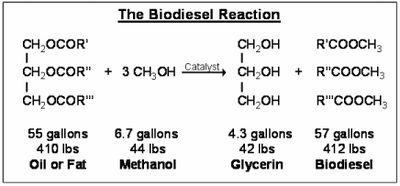Glycerol
Glycerol (glycerin, glycerine) is the main byproduct of biodiesel production. It is a colourless, odourless, viscous, nontoxic liquid with a sweet taste. Pure glycerine has thousands of uses. However, the biodiesel byproduct is crude (and it's not colourless, and it's not only glycerine).
Byproduct in biodiesel production
The lipids extracted from the oil plant feedstock is mainly composed of acylglycerols, fatty acids and other bioactive groups. These fatty acids are release to fatty acid methyl esters by a hydrolysis reaction with methanol using a base catalyst and heat. The glycerol backbone trades its side groups for hydrogens and is stable in this form. It usually forms ~10% of the volume but would vary according to the lipid feedstock.
Purifying glycerol
Glycerol is a dense, viscose, and oily substance that will settle out from the FAME desired main product. A settling vessel that allows the draining of the very bottom of the container where the denser glycerol phase gathers allows removal of most of the glycerol.
Main uses and product ecology
- as mentioned, glycerol is the main by-product of biodiesel production (see our blog post: Open Source Biodiesel Tutorial).
- also a byproduct in the soapmaking process
- Plasticizer in cellulose acetate and polyethylene bioplastics.
- use in biodigestor: feed slowly, very slowly. The addition of glycerin can dramatically increase biogas production (more information here). Special bacterial strains are being developed that can efficiently utilize glycerin to make methane
- when of low purity, can be burned along with biomass such as sawdust
- crude glycerol from homemade biodiesel makes a powerful degreaser.
- feed additive for cattle [1][2][3] and other ruminants (caution ! toxic methanol residues !)
- nitration, to make nitroglycerin (probably not a good idea, unless you want to end up like Nobel's brother)
- other uses: in skin moisturizers, lotions, deodorants, makeup, toothpaste, sweets and cakes, pharmaceuticals and patent medicines, in paper manufacturing, printing ink, in textiles, plastics, electronic components…
External Links
- Journey To Forever: Glycerin
- Science-Projects.com: Making Glycerol from Biological Fats and Oils
- Wisegeek: What Is Glycerin?
- Permaculture.com Making Glycerin Soap from Biodiesel By-Products

